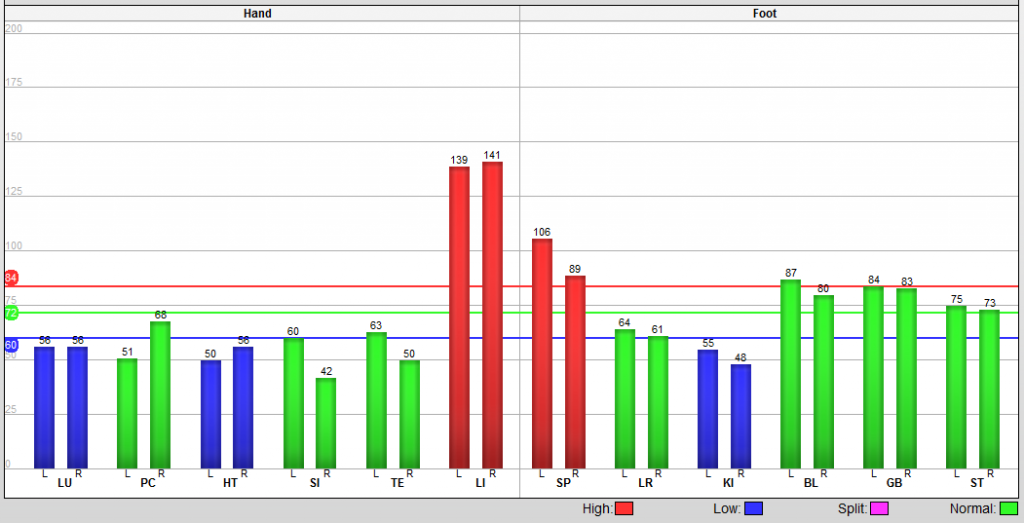Do you have patients who come in for regular acupuncture tune-ups? With patients who come in regularly, you get to know their graphs pretty well. I can usually look at the graph and know if they had been partying over the weekend, if they have had a cold, or if they are under a lot of stress. Recently I had a patient come in and her graph was NOT normal. Well, at least it wasn’t normal for her. Let me show you…
By looking at the graph I started to ask her questions:
- Lung and Large Intestine were both out of balance (Lung was low and Large Intestine was high): Do you feel like you are getting sick? It looks like your immune system is down.
- Heart is low: Any palpitations or insomnia?
- Large Intestine is high: Any sinus congestion, toothache or constipation?
- Spleen is high: Any digestive problems? Have you been working on a big project at the office? Over-thinking or over-worrying?
- Kidney is low: Any problems with low back pain, low libido or ringing in the ears?
She answered NO to almost all of the above questions. This stumped me for a moment because it isn’t typical for her graph to look this way. So then I threw out some key words to see if they matched her emotions:
- Depression and grief (LU)
- Holding onto the past, fear of letting go, crying (LI)
- Anxiety (HT)
- Obsession and worry (SP)
- Disappointment or fear (KI)
She started to cry and said: “My dog died last week…” Now her graph made perfect sense. Every organ system that was out of balance fit her graph perfectly.
Emotions play a very big role in how the energy moves through our bodies. It is normal for us to experience emotions daily, it is only when emotions are excessive or show up very suddenly that they can cause imbalance or illness. The Nei Jing describes the effect that emotions can have on qi:
| Excessive Emotion | Effect on Qi | |
| Joy/Elation | –> | Scattered Qi |
| Anger | –> | Rising Qi |
| Sadness and Grief | –> | Weakened Qi |
| Worry | –> | Stuck or Knotted Qi |
| Fear | –> | Descending Qi |
| Fright | –> | Chaotic Qi |
When the organ system is out of balance due to emotional disturbance, the body cannot run at optimum capacity. It is important to train your patients to come in for acupuncture when they are going through tough emotional situations. By immediately assessing the imbalances which naturally occur from sudden emotional experiences, you will be able to help your patient to get over the emotional crises with greater ease and avoid future health problems that inevitably arise from imbalances in the organ system.
I often get asked by practitioners how frequently I graph my patients. Personally, I graph for each visit. I’m really thankful that I make graphing a priority; not only so that I can detect current problems, but also so that I know know what a normal graph looks like for my patients. When something isn’t right, I’m the first one to know it!
I’d love to hear your stories about being able to notice emotional situations by analyzing the graph. When you share your experiences, we all learn.
Have a great week everyone!
Kimberly Thompson, L.Ac.
Acupuncture Research Analyst
Miridia Technology Inc.



Eu tambem realizo o exame Ryodoraku nas consultas aos meus utentes pelo facto de avaliar a homeostasia jà que sem a avaliar é trabalhar ás cegas!…
Obrigado!
Thank you!